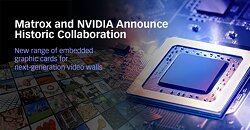Thursday, January 23rd 2020

Matrox to Develop Embedded Graphics Cards with NVIDIA
Matrox today announced a collaboration with NVIDIA for the development of a new range of multi-display embedded graphics cards purpose-built for high-density video walls. Leveraging NVIDIA's industry-renowned GPU technology, Matrox will design graphics innovations powered by a custom-built Quadro embedded GPU to accelerate graphics-intensive video wall applications in commercial and 24/7 critical environments.
"Matrox is thrilled to work alongside NVIDIA, the leader in GPU computing, to bring to market a new standard of high-density video walls," said David Chiappini, executive vice president of research and development at Matrox. "This collaboration is yet another example of our commitment to expanding our video wall portfolio while customers continue to benefit from our graphics expertise, world-class engineering, dedicated technical support, and long product life cycles.""Matrox is a leader in creating graphics-rich video walls that make an instant real-world impact with customers," said Scott Fitzpatrick, vice president of Quadro Product Marketing at NVIDIA. "The exceptional video playback performance, reliability, and longevity of the NVIDIA architecture makes it an ideal platform for the GPUs Matrox is developing for next-generation video walls.
The new series of single-slot graphics cards based on the NVIDIA Quadro embedded GPUs will power up to four synchronized 4K displays per card, while OEMs, system integrators, and AV installers can combine multiple cards to drive up to 16 displays from one system. HDCP is also supported for the playback of protected content across the video wall. In addition, the robust and field-proven Matrox PowerDesk desktop management software provides users with a comprehensive set of advanced tools to easily configure and customize multi-display setups.
"Matrox is thrilled to work alongside NVIDIA, the leader in GPU computing, to bring to market a new standard of high-density video walls," said David Chiappini, executive vice president of research and development at Matrox. "This collaboration is yet another example of our commitment to expanding our video wall portfolio while customers continue to benefit from our graphics expertise, world-class engineering, dedicated technical support, and long product life cycles.""Matrox is a leader in creating graphics-rich video walls that make an instant real-world impact with customers," said Scott Fitzpatrick, vice president of Quadro Product Marketing at NVIDIA. "The exceptional video playback performance, reliability, and longevity of the NVIDIA architecture makes it an ideal platform for the GPUs Matrox is developing for next-generation video walls.
The new series of single-slot graphics cards based on the NVIDIA Quadro embedded GPUs will power up to four synchronized 4K displays per card, while OEMs, system integrators, and AV installers can combine multiple cards to drive up to 16 displays from one system. HDCP is also supported for the playback of protected content across the video wall. In addition, the robust and field-proven Matrox PowerDesk desktop management software provides users with a comprehensive set of advanced tools to easily configure and customize multi-display setups.

23 Comments on Matrox to Develop Embedded Graphics Cards with NVIDIA
Ex: :laugh:
Look around. Multi-screen displays are everywhere. They work.
Matrox is going to create such a proprietary solution. It's in the text.
Matrox did use AMD GPUs in their embedded systems , now Nvidia? Or both.
It can push 8K on a single output - like many other workstation GPUs in this price range.
This solution is about pushing 4x4K, which isn't a big issue performance-wise. Intel IGP and Nvidia basic mobile chips can do three (it's a basic requirement for laptops).
MX250 has enough power to push 4x4K. It's just that it isn't configured to do it. This may be the "customization" that Matrox is going order.
So for 12x4K you can go with:
two Radeon Pro SSG - $5000 each
or
three Quadro P1000 - $300 each
Anyway, Matrox is going for a custom chip, so comparison above doesn't matter.
Remember: this is for running multi-panel screens, not multi-monitor gaming.
It has to be a small, cheap, easily replacable solution.
I understand people like that impress you. But you must understand that while they may be very tech-savvy, they don't have the know-how / experience / processes an enterprise IT team normally has.
The fact that Linus had trouble setting up a multi-panel screen doesn't mean it is difficult.
The very basic observation: multi-panel screens exist. They are everywhere. They've been here for just as long as high-resolution colour LCD screens have.
If you (your company) doesn't know how to do it, you call another company that knows. They send you a young IT technician who has no idea how GPUs or LCDs work, but he'll get it done in 5 minutes.
Video walls, commercial 24/7 applications. It also mentions "embedded GPUs".
They also make solutions with "modules", but these are not normal (general use) graphics cards:
matrox.com/graphics/en/products/video-wall/mura_mpx_series/
The goal is to group the particular screens in different ways. It can be a single "16K" (4x4 4K), 4x8K, 16x4K and so on.
Even if you put four workstation cards in a PC, it won't be able to do this.
Matrox provides the abstraction layer that's necessary here.
Now, I don't know why they've chosen Nvidia as a partner, since making this kind of custom chips used to be AMD's specialty.
Maybe they're just cheaper and more flexible than AMD (7nm) at this point. This is a low volume product after all.
Anyone remember the Parhelia?
We're discussing this because TPU occasionally posts very random news - just because some brand exists in the text.
For example, you have a 16 ports USB3.2 hub and you connect on each port a monitor via a DVI or an HDMI adaptor. Then you have a 16 monitor setup. Yeah, those setups are from '90s, when analog was at power.
Also, since it seems there won't be any splitting, this could be a purely software-based solution made specifically for Nvidia GPUs (custom or not). Matrox already does that:
www.matrox.com/graphics/en/products/multi_display_software/powerdesk/